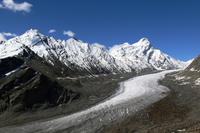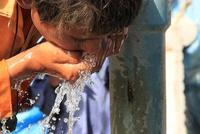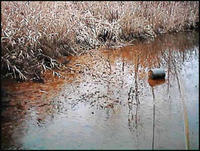-
Ninth-grader wins award for solar-powered water purification system
Ninth-grader Deepika Kurup of Nashua High School in New Hampshire won $25,000 and named America’s Top Young Scientist for her innovative new water-purification system; her prototype, which harnesses solar energy to disinfect contaminated water, can help improve the lives of the 1.1 billion people around the world who lack access to clean drinking water
-
-
UV offers hope for safer drinking water
Recent changes in the Environmental Protection Agency’s (EPA) surface water treatment rules mandate, among other things, more aggressive monitoring and control of various pathogens, notably including Cryptosporidium; this microbe, which can cause severe illness or death, is highly resistant to chlorine-based disinfection practices; as one means to reducing the threat, the EPA has called for treating water with ultraviolet (UV) radiation, which also serves as a “secondary barrier” to inactivate (prevent reproduction of) other key pathogens such as adenovirus and other viruses, as well as bacteria and parasites such as Giardia
-
-
Climate change, water shortage play only secondary role in causing conflict – at least so far
Intelligence services and militaries around the world have been talking about, and preparing for, the danger of “water wars” and about climate change as a threat to national security; the results of an EU-funded research project, however, found that such discourses oversimplify a complex reality; climate and water resource changes are important, but play only a secondary role — at least for the time being — in the causation of conflict and insecurity compared to political, economic, and social factors
-
-
U.S. intelligence forecast: growing interstate conflicts over food, water

The U.S. National Intelligence Council, the research arm of the Office of the Director of National Intelligence, yesterday released its Global Trends 2030; the report’s authors say that food, water, and energy will be more scarce; “Nearly half of the world’s population will live in areas experiencing severe water stress,” the report notes; Africa and the Middle East will be most at risk of food and water shortages, with China and India also vulnerable; one bright spot for the United States: energy independence sometime between 2020 and 2030
-
-
Water resources management in a changing world
Visualize a dusty place where stream beds are sand and lakes are flats of dried mud; are we on Mars? In fact, we are on arid parts of Earth, a planet where water covers some 70 percent of the surface; how long will water be readily available to nourish life here? In the United States, more than thirty-six states face water shortages; other parts of the world are faring no better
-
-
World’s great rivers running on empty
Four of the world’s great rivers are all suffering from drastically reduced flows as a direct result of water extraction, according to new research; the researchers found that in all four river basins, over a long period of time, outflows have greatly reduced as a direct result of increased water extractions, and that urgent changes in governance of water are needed to ensure the systems remain healthy and viable
-
-
How groundwater pumping affects streamflow
Groundwater provides drinking water for millions of Americans and is the primary source of water to irrigate cropland in many of the nations most productive agricultural settings; although the benefits of groundwater development are many, groundwater pumping can reduce the flow of water in connected streams and rivers — a process called streamflow depletion by wells; new USGS report describes processes and misconceptions concerning the effects of groundwater pumping on streamflow
-
-
Snowpack, essential freshwater source for billions, threatened
Snowpack, an essential source of drinking water and agricultural irrigation for billions of people, could shrink significantly within the next thirty years; the news is particularly troubling for snowpack-dependent California — the largest producer of agriculture products in the country and the sixth-largest agriculture exporter in the world; by filling reservoirs and watering crops when warmer, drier weather sets in, mountain snowpack has become vital to people and ecosystems in regions such as the Western United States, Alpine Europe, Central Asia, and downstream of the Himalayas and Tibetan Plateau — home to more than 50 percent of the world’s population
-
-
Himalayan glaciers to shrink even if temperatures hold steady, risking South Asia water supply

Come rain or shine, or even snow, some glaciers of the Himalayas will continue shrinking for many years to come; the most conservative findings of a new research on Bhutan, a region in the bull’s-eye of the monsoonal Himalayas, indicate that even if climate remained steady, almost 10 percent of Bhutan’s glaciers would vanish within the next few decades; what is more, the amount of melt water coming off these glaciers could drop by 30 percent
-
-
New tool for incorporating water impacts into policy decisions

Just-released paper offers policy makers innovative framework for linking human well-being and water quality; a new tool helps in assessing and valuing the many services clean water provides — from recreation and beauty to navigation and hydropower — and incorporating them into policy decisions
-
-
Cleanup of most contaminated U.S. groundwater sites unlikely for many decades

At least 126,000 sites across the United States have contaminated groundwater that requires remediation, and about 10 percent of these sites are considered “complex,” meaning restoration is unlikely to be achieved in the next 50 to 100 years due to technological limitations; the estimated cost of complete cleanup at these sites ranges from $110 billion to $127 billion, but the figures for both the number of sites and costs are likely underestimates
-
-
USGS sampling water in Hurricane Sandy’s aftermath to ensure public health
Excessive nutrients in U.S. rivers, streams, and coastal areas are a major issue for water managers, because they cause algal blooms that increase costs to treat drinking water, limit recreational activities, and threaten valuable commercial and recreational fisheries; U.S. Geological Survey crews are sampling water for nutrients, sediment, and pesticides to document water quality in areas affected by the hurricane
-
-
Making toilets out of waste plastic
Washington Open Object Fabricators (WOOF) has won the 3D4D Challenge, and awarded a prize of $100,000 to help toward implementing the winning project – which will enable waste plastic to be used as filament for 3D printing machines, to create new products; the winning team plans to use the winning technology to address local issues in water and sanitation in Oaxaca, Mexico
-
-
Large-scale production of algae-based biofuels poses sustainability concerns

Scaling up the production of biofuels made from algae to meet at least 5 percent — approximately thirty-nine billion liters — of U.S. transportation fuel needs would place unsustainable demands on energy, water, and nutrients, says a new report from the National Research Council; these concerns, however, are not a definitive barrier for future production, and innovations that would require research and development could help realize algal biofuels’ full potential
-
-
Ozone causes forests to use more water, reducing availability in the Southeast

Scientists have found that rising levels of ozone, a greenhouse gas, may amplify the impacts of higher temperatures and reduce streamflow from forests to rivers, streams, and other water bodies; such effects could potentially reduce water supplies available to support forest ecosystems and people in the southeastern United States
-
- All
- Regional
- Water
- Biometrics
- Borders/Immig
- Business
- Cybersecurity
- Detection
- Disasters
- Government
- Infrastructure
- International
- Public health
- Public Safety
- Communication interoperabillity
- Emergency services
- Emergency medical services
- Fire
- First response
- IEDs
- Law Enforcement
- Law Enforcement Technology
- Military technology
- Nonlethal weapons
- Nuclear weapons
- Personal protection equipment
- Police
- Notification /alert systems
- Situational awareness
- Weapons systems
- Sci-Tech
- Sector Reports
- Surveillance
- Transportation
Advertising & Marketing: advertise@newswirepubs.com
Editorial: editor@newswirepubs.com
General: info@newswirepubs.com
2010-2011 © News Wire Publications, LLC News Wire Publications, LLC
220 Old Country Road | Suite 200 | Mineola | New York | 11501
Permissions and Policies
Editorial: editor@newswirepubs.com
General: info@newswirepubs.com
2010-2011 © News Wire Publications, LLC News Wire Publications, LLC
220 Old Country Road | Suite 200 | Mineola | New York | 11501
Permissions and Policies
